With all the posts about seal tags lately, I haven't been talking about my other two favourite things (after research) - string and 12th C clothing. Well let's fix the former (even though eventually I'll get to fibre seal tags), by talking about a few of the great controversies of narrowwares and string crafts. Sorry, this is a musing, not at informational article, just warning those who hope to find facts and figures today.
Is knitting medieval?
If you look at old books on knitting, you'll find a lot of objects identified as knitting in the medieval period. And then if you look at more recent investigations of these objects, you'll learn many of them are naalbinding. Or occasionally sprang. The writers of the old books did the best they could - they knew it wasn't sewing of even crochet, but never having knitted themselves nor having heard of naalbinding, they didn't think to see if it was a very similar technique.
There is some medieval knitting, in fact in the coptic areas there is even some pre-medieval knitting. But the vast majority of western European medieval items that look like knitting so far that I've heard of are naalbinding. New techniques like knitting take time to permeate to craftspeople, so both coexisted for a while. And even though knitting has a definite speed advantage over naalbinding, naalbinding doesn't unravel, so both have reasons for their use. To make things more complicated, the word knitting in English is not only used for the technique of making a fabric from string using 2 or more eyeless needles, it is also rarely (and increasingly less so over time) used for the process of making things sit together eg a wound knits together, knit fabric. In languages other than English, this happens even more so, so if a translation has occurred, the word knitted may simply mean anything which is in this family of construction via meshing strings together (eg crochet, knitting, naalbinding, sprang).
By the Renaissance, knitting had taken off, and there are a lot more examples. I'm really talking about the early days of knitting - the 11th to 13th Centuries.
Anyway, if I see an article identifying a piece as knitting in the medieval period, I can't be sure it truly is knitting unless it discusses the possibility that it could be in other similar techniques. (like this one) If I want to make something quickly, and wasn't aiming for museum replica quality, then knitting might be a good choice, but being a research person I'd probably be researchin a naalbinded article and trying to understand how I'd have to adjust for the difference in technique, and how that has minor effects on the finished result.
Was crochet used in the Renaissance?
No. probably not.
But surely someone would have thought up something so easy? All the things needed to do crochet were about (string + hooks).
There were already a number of techniques about that did this. Crochet takes more valuable thread than these. Why try inventing new things when what you want to do can be done with existing techniques? What piece of imagination sparks people to develop a new technique? The above articles suggest that crochet develops from tambor (chiefly used post Renaissance), crochet becoming fabric-less tambor.
If you wanted to make a good recreation, then without more evidence, you wouldn't be using crochet, except as discussed above as a quick way to mimic another technique.
Are lucet's used before the Renaissance?
Well, the most well known controversy of them all. And one that has had lots written about it. Were lucets used before the Renaissance, especially in "viking" times? The evidence I've heard cited consists of many objects which can successfully be used as lucets, but could also have some other use, and a single piece of string. Unfortunately for the advocates, the article concerning the piece of string doesn't consider the possibility that other braiding techniques might have been used and discount them. For me this isn't good evidence, so we can't prove pre-Renaissance usage of the lucet. And with a limited number of braided cords being found in securely dated contexts and even less of them analysed by braiding experts, I don't think it likely we will get the evidence needed anytime soon. Only a handful of positively identified examples of fingerloop braiding, finger weaving and plaiting exist from these eras.
The use of the lucet in the Renaissance is fairly well doccumentable in linguistic terms although I haven't heard of extant lucets, although again I've heard of no conclusively identified braids in the technique. The quantity of evidence for fingerloop braiding suggests to me that fingerloop braiding was more common, although the greater possible complexity of fingerloop braiding is likely to bias this sampling.
Structurally the internal structure of lucet is quite different to fingerloop braiding, plaiting and fingerweaving, but the external appearance is quite similar to these techniques. I have no problem substituting lucet cord for other techniques, only with those who firmly assert facts ("the vikings used lucets") that really aren't that firm.
Is Kumihimo period?
It seems to be taken for granted by people that Kumihimo is period, because modern craftbooks says it is (just like all the knitting ones did). "Everybody knows" samari armour was held together with kumihimo. By now we should know better than to make such assumptions, but perhaps the problem is that this is a japanese technique, so I expect there is a lot of scholarly research in Japanese, and not in English which we can research ourselves. This isn't a great controversy yet because very few people know of it, but I think it should be, and will be in times to come.
LMBRIC investigates a few fragments of braid from Xth Century Samari armour, and comes to an interesting conclusion - that they are loop manipulation not kumihimo (see n5, n7, n10, n9). The Japanese version of loop manipulation (fingerloop braiding) holds the loops on the hands/arms, producing some end results that are nearly indistinguishable from kumihimo. The authour of the article finds a few moves, however that are only possible by loop manipulation and not kumihimo. This to me throws all existing claims of ancient kumihimo open to suspicion. Just as for knitting, now all claims that an object is very old kumihimo now need to substantiate why they aren't loop manipulation.
As with knitting and lucet, this isn't about what you should and shouldn't do - to me if the desired result of recreation is the finished product, then the method only matters for the utmost highest levels of obsessive authenticity, and I'm very happy to make compromises and use structurally identical results. It's about not making historical claims that haven't been substantiated.
Was there really such a thing as viking whipcording?
Asfridr provides a nice run down of the evidence, or more accurately, general lack of evidence for this art form. Basically strings using this structure have been found, but no evidence they were made in this manner, rather than simple plaiting is shown.
It's a cool way to get people doing braiding, and the result is structurally identical, but I really regret that it's not actually provable because I've found it a cool way to get people to braid at demos, so I end up having to decide between authenticity and entusiasm, instead of being able to have both.
How old is macrame?
The problem with this question is that you have to define what is macrame. When does something cross the line from a few knots to being macrame? There are decorative fringes like this one that utilise decorative knotting, nets that use repeated knots, turk's head knots on pouches and various other usages. But I these don't necessarily constitute a structured art of knotting. I think they might be more like tying your shoelace - they are knots used, but fall into the category of something else (eg "what you need to know to get dressed", or the knot you put on the top of a tassel).
One of the origins of macrame is in sailor's knots being used for non-sailing decorative purposes. I suspect this practise increased greatly with the late Renaissance and later numbers of sailors away from shore for long periods stuck on a ship with nothing to do and a knowledge of knots. But you could mount a good counter argument regarding fishermen stuck in port in bad weather.
At any rate, I'm more comfortable with describing early pieces which have some knots on them as "decorative knotting" than macrame, because to me, the majority of pieces will be in combined techniques, not able to be made from knotting alone. And it's going to be hard work for anyone who wants to search for pre-modern examples of decorative knotting, because it'll be listed in the museum catalog as something else (pouch, tassel, cingulum, etc). Looking at he concept of pasimentarie might be useful though.
inkle looms
If you tabletweave, you probably know this one. An inkle is a Renaissance English term for a narrow woven band. The modern "inkleloom" is probably a 1930's invention, maybe up to 50 years earlier, so named because it can be used to make inkles.
All the evidence points to the common looms for making inkles in medieval and Renaissance times being band looms or box looms using either cards or a rigid heddle.
A modern inkle loom will produce structurally identical results, but please don't try and contort logic and linguistics to justify bringing it to a high authenticity demo.
Wednesday, 1 September 2010
great string controversies
Labels: fibre arts
Tuesday, 24 August 2010
Slit patterns on dependant parchement seal tags
One slit
The simplest slit pattern is to create a single slit in the parchment. The slit is standardly made in the folded up section (where the parchment is doubled), near the top of the folded section. That is the knife runs across the parchment once, but cuts both pieces of doubled parchment, ie one pair of slits. This is likely to be the strongest location for the slit, giving the most wear resistance. The example below shows both front and rear of a document, showing how simple the single slit is.

 Feoffment by Thomas Stoteville and John Aston to William Cotton and others of lands in Saxton, Wood Ditton and elsewhere in Cambridgeshire.
Feoffment by Thomas Stoteville and John Aston to William Cotton and others of lands in Saxton, Wood Ditton and elsewhere in Cambridgeshire.Saxton, Wood Ditton, 1453
Seals: Red wax impression on front only
Tags: single piece of parchment passed through one pair of slits in doubled parchment
(McMaster University British Legal Instruments Collection No. 16)
Here's another example of the same slit pattern, this time with the tag removed and the paper unfolded, and laid flat. We see two slits as this single slit was made through two layers of parchment at once.

Quitclaim by John Judd to John Knight of the property of Motynnescroft in Tonbridge, Kent.
1449/50
Seal & Tag: missing
(McMaster University British Legal Instruments Collection No. 3)
In the final example of this pattern, the folded parchment has unfolded under the tag on the right (front - left on the back), and can be compared to the other tag which is threaded through the folded parchment. This shows the simple arrangement of tag and parchment and that there is no fixative or other fancy folding happening.

 Instrument of sasine with charter by Robert Levingstoune to John Bog and Cristine Anderson of an annual rent of 12 merks. 1580/81.
Instrument of sasine with charter by Robert Levingstoune to John Bog and Cristine Anderson of an annual rent of 12 merks. 1580/81.Seals: Red wax impression on front only
Tags: single piece of parchment passed through one pair of slits in doubled parchment
McMaster University British Legal Instruments Collection No. 43)
You may have noticed in the previous example, the tag on the left (front left) was not pulled down as low as it could be, but rather had been pushed up like a pop up book. Both this and the unfolding of the parchment might have been encouragement for high class scribes to develop more complex slit patterns that would better hold all portions of the document in place, as discussed in the next section.
Three slits
A pattern of 3 slits (3 sets when folded) is the other most commonly used way of threading a dependant parchment seal. The example below shows the near ubiquitous arrangement - as in the one slit, the first slit is made in the folded section, as close to the top of it as possible, cutting through both layers of parchment. The second slit is made in the centre of the folded section, also through both layers. The final slit is made through one layer, located on the fold of the document.
 Confirmation of grant
Confirmation of grantBefore 1204
Richard II du Hommet confirms the grant at Langrune-sur-Mer made by his father William du Hommet, the constable of the king of England, to the monks of Aunay.
Slits: 3 slits, 2 through doubled parchment and one through fold
Tag: single piece of parchment
(Caen, AD Calvados, H 912)
While different threading patterns could be constructed with these slits, where the backs of the document can be seen, or details of where the rear portion of the tag emerges from the slits, the evidence I've seen all points to one pattern being in use. The tag begins inside the document at the top, threads out through both front and rear holes, then back in through the middle holes in front and rear, then emerges from the document through the slit on the fold. This sounds rather complicated, so I'll post a set of photos of how to do this soon. An example showing front and rear of a document in this folding pattern is below.

 Quitclaim by Margery Addington to John Addington of the manors of Harlow and Alderbrook, Essex and other lands in Essex and London.
Quitclaim by Margery Addington to John Addington of the manors of Harlow and Alderbrook, Essex and other lands in Essex and London.Essex, 1557/58
Tag: Folded tag passes through two slits in folded portion and one slit on fold of parchment
Seal: red wax seal, depicting a (woman's?) portrait, facing to the right.
(McMaster University British Legal Instruments Collection No. 49)
While this isn't as easy to construct as other possible patterns, this is much more resistant to tag movement, holding the tag more firmly in place, with the two sides of the document providing double reinforcement for the document.
3 slit variants
I mentioned at the start that a few variations on the slit patterns exist. The first is to move the top slit to above the fold in the parchment. This can be done with a single slit or a 3 slit pattern, examples of both below. I expect this to be weaker than passing through both layers of parchment, which probably accounts for the rarity of this variation.
 Document
DocumentJuly1374 - 1375
Tags: two remnants of tags passing through a slit above the fold in parchment, a slit in the middle of the folded section of the parchment and a slit in the fold of the parchment.
(Swedish Archives DS8799)
Another stranger variation to the 3 slits is shown below - the top slit is made above the fold and two slits are made in the folded section - none on the fold. It seems to have worked fine as an attachment method.
 Confirmation of cathedral chapter of episcopal grant,
Confirmation of cathedral chapter of episcopal grant, 1149 ?-1154
(DCM, 1.6.Spec.20)
Finally an example where the back is not symmetrical with the front - the back of the tag was not passed through either slits -right hand side of first picture (front), left hand side of second picture (back):

 Document
DocumentJuly1374 - 1375
Tags: three seal tags on the front of parchment pass through 2 slits in the doubled parchment and one on the fold of the parchment and on hte back 2 pass through 3 slits while on passes through only one slit
Seals: 2 seals green or dark wax front and natural wax backing, one seal obscured by a seal bag
(Swedish archives DS8829)
Given that this is just one of 3 tags done this way on this document, lets assume it was a mistake, and the tag was intended to pass through all the slits.
The mythical 2 slit pattern
In theory various combinations with two pairs of slits (or simply two slits in an un-doubled parchment) ought to be possible. The example below at first looks like 2 slits , but look carefully - the doubled parchment has been smoothed down. Turn it back up again, in such a way that it ends just a nice distance below the words and this example is actually a single slit pattern.
 Account of the commons of North Shorwell, Isle of Wight.
Account of the commons of North Shorwell, Isle of Wight.North Shorwell, Isle of Wight, 6 Oct. 1501
Manuscript: In Latin
Tag: passes through two slits
Seal: red wax seal, depicting a crown?
(McMaster University British Legal Instruments Collection No. 18)
Another 13th C example of this phenomenon can be found on the 13th century private charter of Alan de Witcherche (British Library, add. charter 20592) on the medieval writing site.
While I think a pattern with 2 pairs of slits should be possible, I still haven't found any examples yet, so I wouldn't be sealing any documents this way.
Other slit patterns
I'm yet to find any good evidence for any slit patterns not mentioned above. I'm sure if I find enough examples of sealed documents, something out of the ordinary, or some regional variant like the clever variations the Swedish made on integral tags will turn up, but the above certainly seems to cover the majority of examples. If you spot anything you think might be different, please let me know.
Labels: seal tag
Saturday, 7 August 2010
Examples of separate parchment seal tags
As discussed a couple of posts ago, integral seal tags were a thoroughly useful tool, but the slit vellum, had a built in weakness - the small unslit portion could tear, as can be seen from a number of damaged period items. So new types of seal tags were developed, such as the separate seal tag. I've previously outlined the differences between integral seal tags and separate seal tags, today's post is to provide some examples of this type of sealing.
Examples are again, roughly chronological, with links to the full size image available by clicking the picture and links to the source by clicking the text. My (sparse) comments upon the tags are in italics. A few conclusions drawn about this type of seal tag are given at the end.

Roger, Margery and Milo de Bray giving land to Priory of Haliwell.
Haliwell Priory, Middlesex, ca. 1181-1188
Manuscript: In Latin on vellum, 13x14 cm (including 3cm fold)
Seals: red wax, diameter 5 cm (Roger), 6x4 cm (Margery).
(Schoyen MS 1648)
 Sealed charter of 'Count Robert son of Count John' (Count Robert of Alençon, d.1217) for the abbey of St-André-en-Gouffern
Sealed charter of 'Count Robert son of Count John' (Count Robert of Alençon, d.1217) for the abbey of St-André-en-GouffernCaen, c1191-1200.
(AD Calvados H 6512, no. 4)
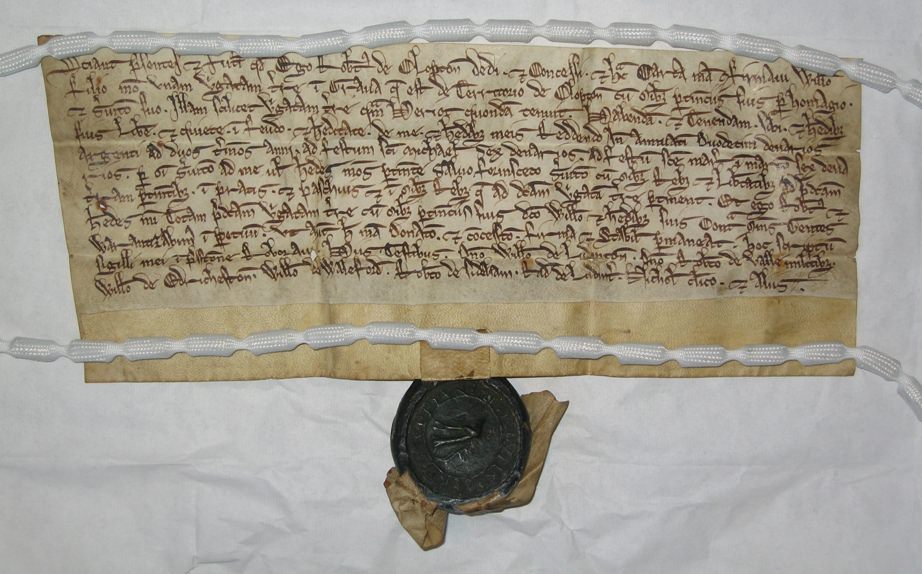
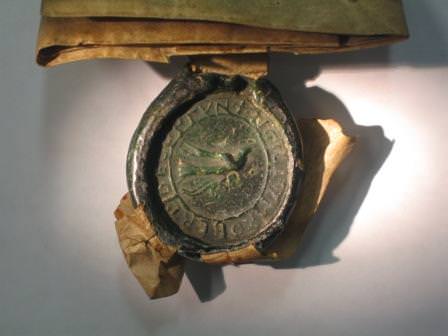 The "Clopton Charter"
The "Clopton Charter"13th C
Manuscript: Vellum, approx 11cm by 25 cm.
Text:Latin, records a grant of land by Robert de Clopton to his son, William.
Seal: image of a bird, approx 4cm diameter.
 Letter patent of Henry III in favour of his half-brother William de Valence
Letter patent of Henry III in favour of his half-brother William de Valence13th C
 Doccument
Doccumentmid-late 13th C
Seals: Henry of Bishopthorpe and his wife Matilda, probably manufactured as a matched pair
(British Public Record Office DL 25/3089)
 Inspeximus by Bishops of Durham, Ely & Coventry witnessing Edward I ending alliance with Guy of Flanders against Philip I of France.
Inspeximus by Bishops of Durham, Ely & Coventry witnessing Edward I ending alliance with Guy of Flanders against Philip I of France.Wasingham, England, 6 February 1297,
Manuscript: French and Latin on vellum, 36x51 cm (unfolded),
Seal: red wax seal bishop of Durham,
Tags: partial seal tag and slit for 3rd seal tag.
(Schoyen MS590/26)
An inspeximus is apparently essentially the medieval equivalent of a statutory declaration - these bishops of good standing bear witness that they saw the original document.
 Deed of gift from John Morel to his son, William Morel, of an assart of land
Deed of gift from John Morel to his son, William Morel, of an assart of landStafforshire, c1300
Manuscript: 175x145mm with elaborated initial.
Tag: original seal tag
Seal: loose fragment of a brittle white wax seal
July1374 - 1375
(Swedish archives DS8682)
 Document
DocumentTorun, Poland, 1364
Signatories: Earl of Northampton & four English knights
Seals: Central seal in English style, others manufactured in Poland in Polish style
(London Public Record Office DL 25/1639)
 Document
Document1392
(British Public record Office E 329/228)
 Robert Stewart, Governor of Scotland confirms land grant held by William de Crawfurde
Robert Stewart, Governor of Scotland confirms land grant held by William de CrawfurdeFalkland, Scotland, 24 April 1417.
Manuscript: Vellum, 21x33 cm (unfolded)
Seal: Great Seal of Scotland, white wax, diam. 10 cm.
(Schoyen MS 1656)
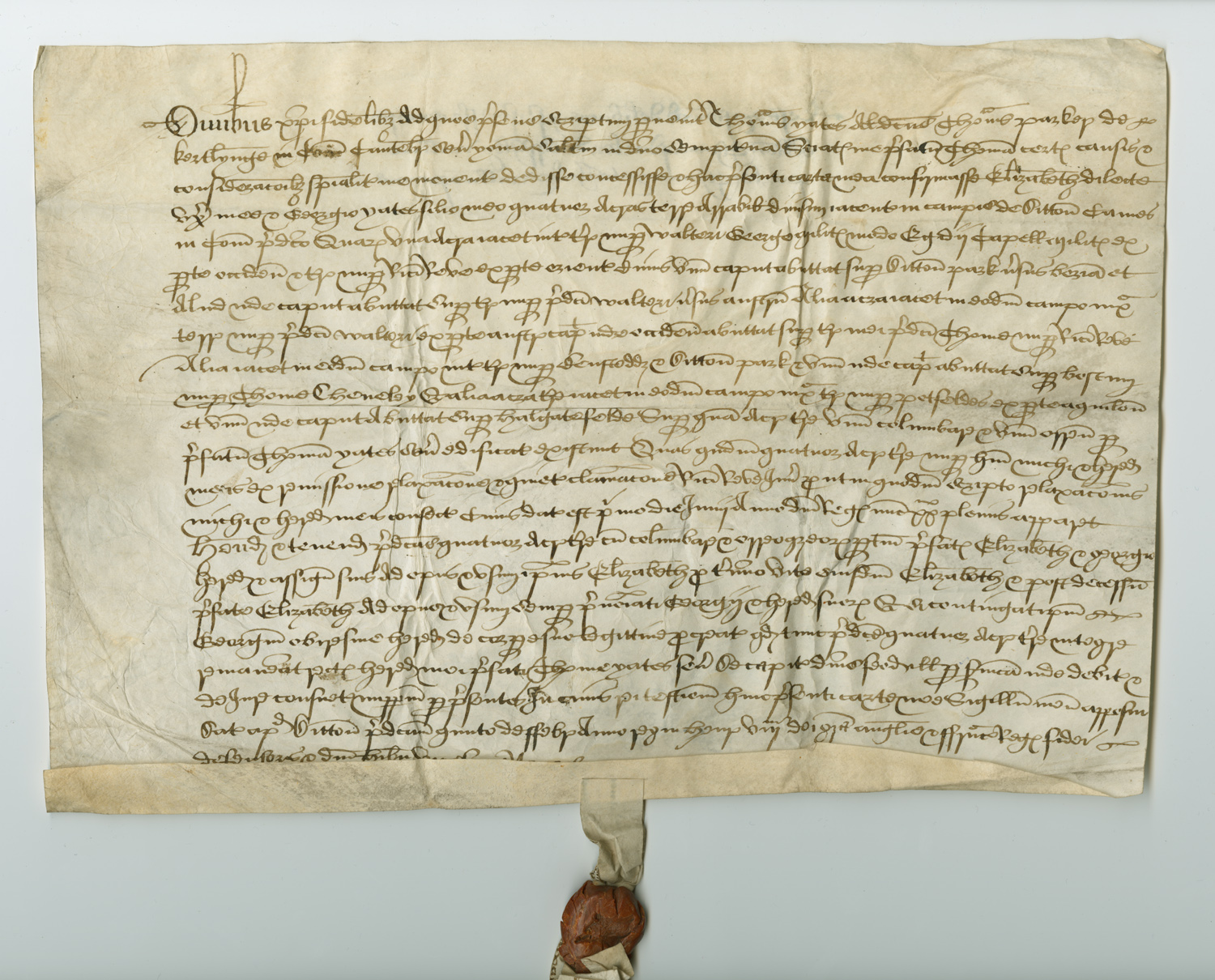
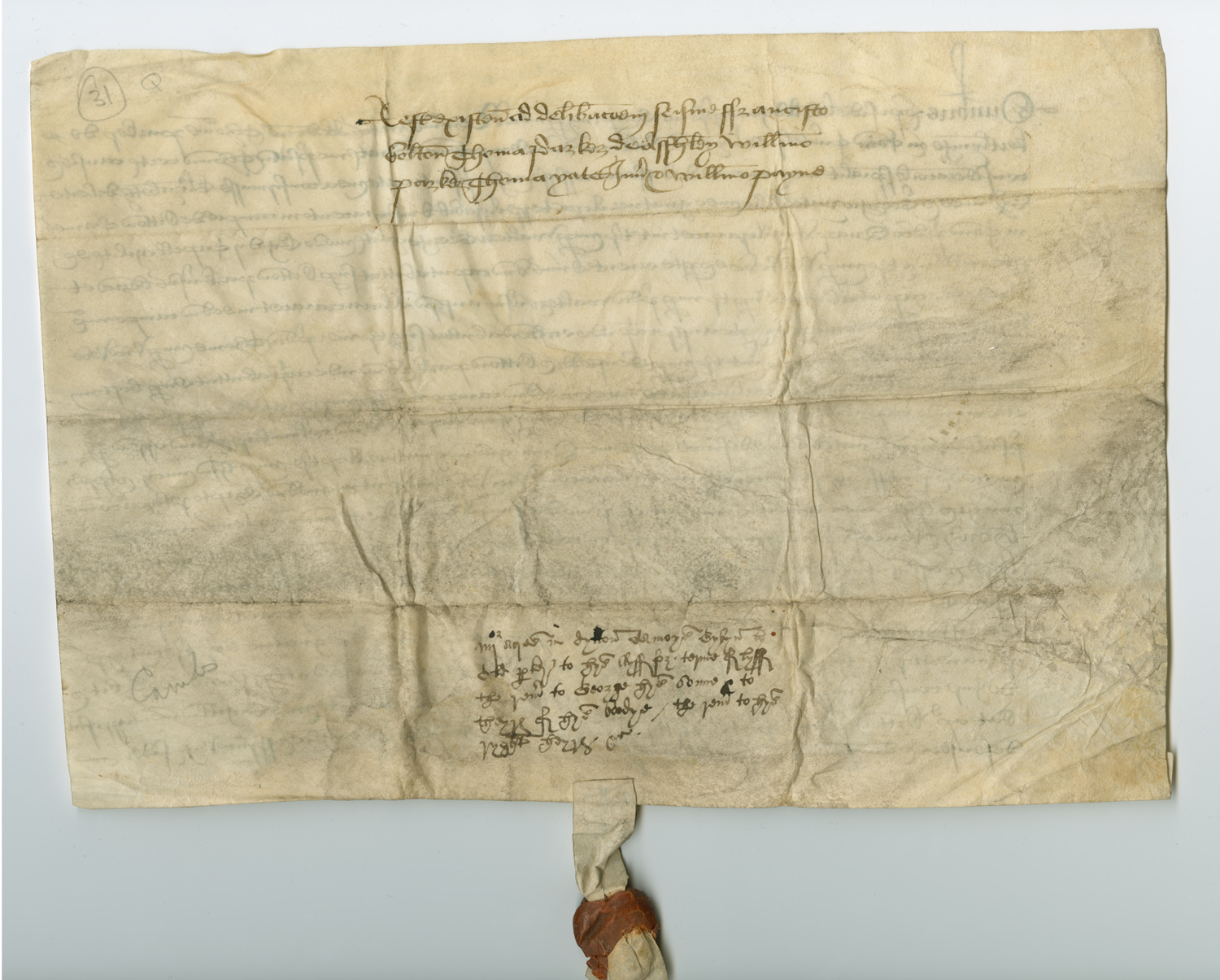 Feoffment by Thomas Yates alias Parker to Elizabeth, his wife, and George, his son, of lands in Ditton Camoys, Cambridgeshire.
Feoffment by Thomas Yates alias Parker to Elizabeth, his wife, and George, his son, of lands in Ditton Camoys, Cambridgeshire.Ditton Camoys, Cambridgeshire 5 Feb. 1537/38
Manuscript: Deed poll.
Seal: red wax seal, cracked, depicting coat-of-arms
Tag: made from waste parchment, reading: “[...] del[..] ad qua[...] Gilbertus Randolph de [...] Gilbertus [...] relaxasse ac [...].”
(McMaster University British Legal Instruments Collection No. 31)
Note the tag made from waste parchment, with the writing mostly hidden on the inside - a fairly common practise. You can fairly clearly see the folding pattern of this document, and writing on the back, presumably an address or summary.
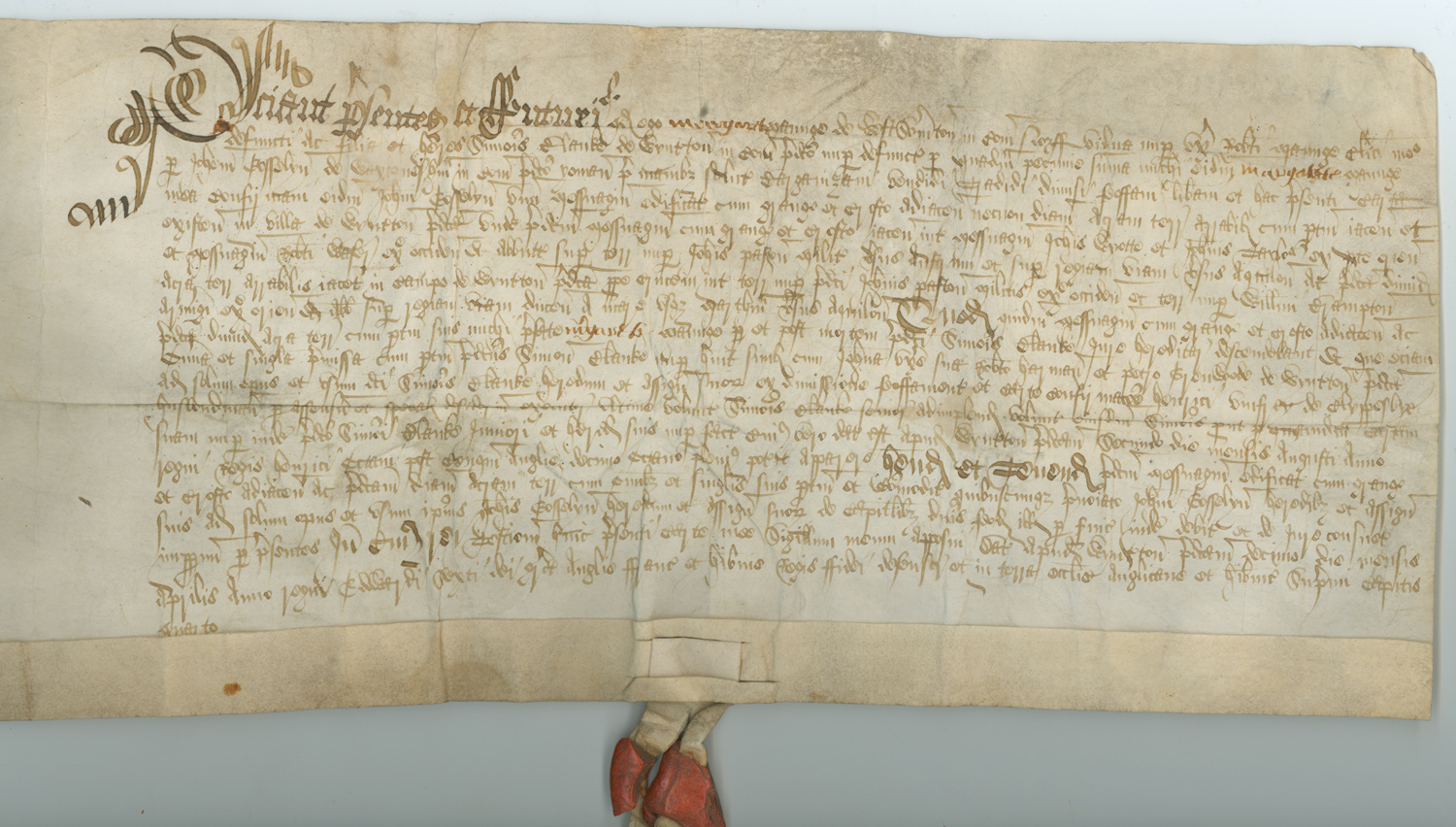
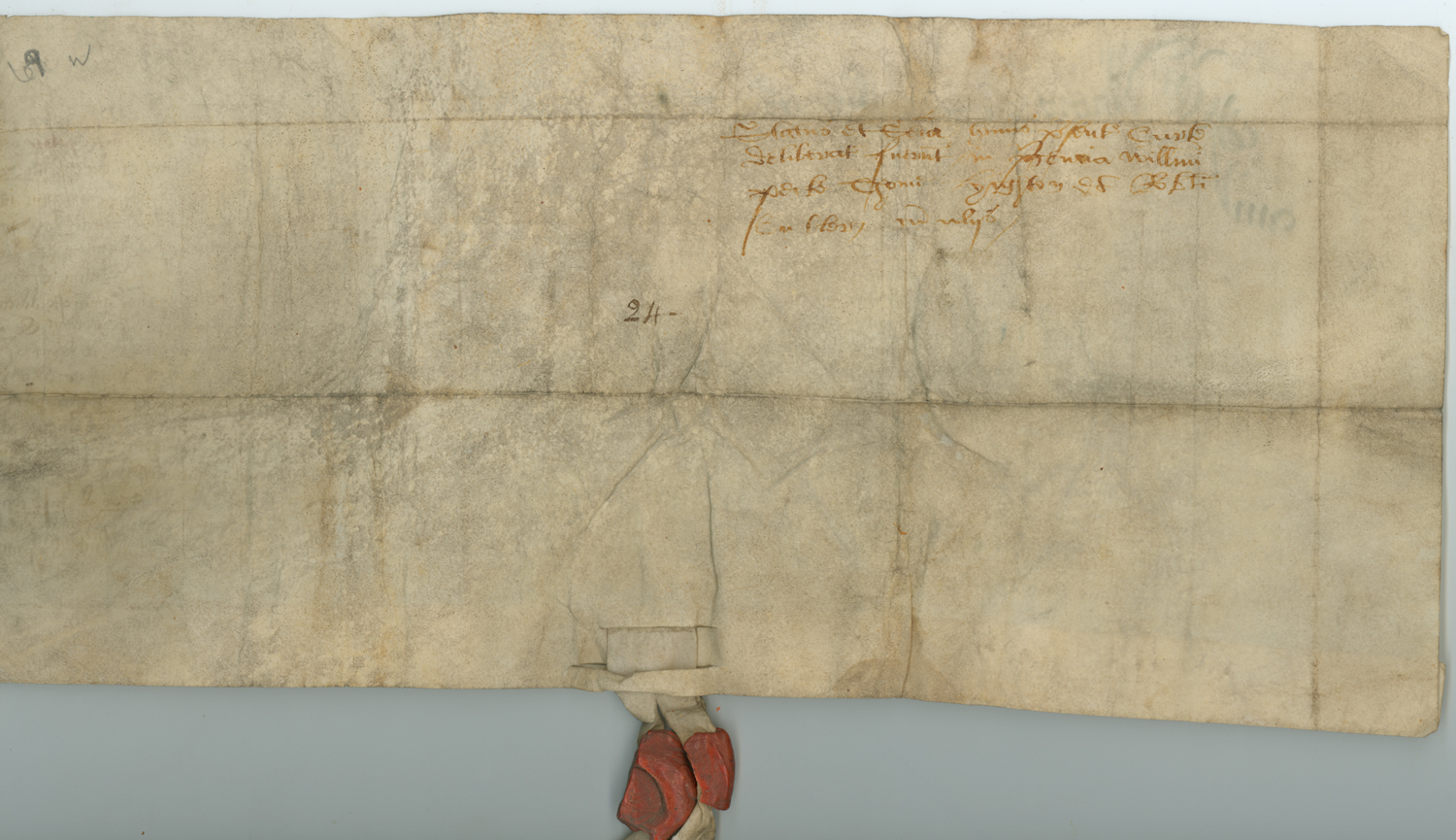 Feoffment by Margaret Maunge to John Gosling of a messuage and lands in [Winterton?,] Norfolk.
Feoffment by Margaret Maunge to John Gosling of a messuage and lands in [Winterton?,] Norfolk.1550
Manuscript: Deed poll.
Seal: red wax, cracked, half missing.
(McMaster University British Legal Instruments Collection No. 65)
 Adam Bothwell, Bishop of Orkney appoints Francis Bothwell to Chaplaincy of St Lawrence.
Adam Bothwell, Bishop of Orkney appoints Francis Bothwell to Chaplaincy of St Lawrence.Kirkwall, Orkney, 3 April 1565
MS in Latin on vellum, 18x45 cm, (unfolded), episcopal seal of Adam Bothwell, (red wax diam. 6 cm)
(Schoyen MS 1676/1)
Who said nepotism was a new thing?
 Indenture (title deed) to lands in Tenterden, Kent.
Indenture (title deed) to lands in Tenterden, Kent.3rd of April 1574.
Vellum 14.5x30.2 cm. Mostly undamaged wax seal on original vellum tag.
(Griffin Manuscripts sale catalogue Number 24103)
 Devise of land by John and Mabell Huntley to Hugh Huntley, their son
Devise of land by John and Mabell Huntley to Hugh Huntley, their son1 January 1577/8
Manuscript: Vellum, 15 5/8” x 10 3/4”.
Seals: Two pendant seals, one fragmentary.
 King James VI of Scotland grants property to John Anderson.
King James VI of Scotland grants property to John Anderson.1599
Manuscript: Ink on parchment, 45 cms. X 18.8 cms.
Seal tag: Parchment 21cm in total length.
Seal: Tan-colored wax double sided royal seal, approx 14cm original diameter, only upper right quarter remains.
Some conclusions on the style
From this very small sample we can see that this form of tag started to become common during the 12th C and continues throughout the medieval and Renaissance periods. The development of separate parchment tags was to quickly become the most common type of seal tag. As well as being stronger and more secure than the integral seal tag, this style also had the advantage of multiple seals being easier to add, a practise which reached ridiculous heights by the 13-14th C. This little slip of paper is the most common style of tag of all styles found - it has by far the most examples extant, far more than integral tags or all the styles of fibre seal tags put together.
Labels: seal tag
Attempts to strengthen integral seal tags II
Following on from part I, some Swedish examples. Why Swedish? Because the Swedish Archives have a lovely collection online, a snapshot of documents from 1374-1375.
Swedish slit tags
A number of Swedish integral seal tags show a characteristic which I think is another way to attempt to relieve stresses on integral seals tags. One of the weakest points on the seal tag is where the slit ends. This point is pulled and pushed around by the weight of the seal and by people pushing the seal to dangle below the document. The Swedish documents instead of a simple horizontal slit, start with a small diagonal cut before cutting the horizontal cut. I believe this is likely to relieve the stress of the end of the cut a bit.
Here's a few examples:

Sweden, 1374-5
(Swedish National Archives DS8653)
The tag is folded up a little, but the 2nd image of the back shows the slit clearly.

Sweden, 1374-5
(Swedish National Archives DS8658)
You can see how the slit opens up a little to distribute the stress of the tag pulling away.

Sweden, 1374-5
(Swedish National Archives DS8712)
The seal has fallen off this document, but tag is intact - so the tag was stronger than the wax.
These still did break, even if they might have been a bit stronger:

Sweden, 1374-5
(Swedish National Archives DS8866)
A tear is starting continuing the diagonal slit into the parchment. A second tear is seen a little further down the tag.

Sweden, 1374-5
(Swedish National Archives DS8783)
The point jsut a little further down the tag seems to be the main stress point for this style of tag.
 Document
Document
Sweden, 1374-5
(Swedish National Archives DS8793)
The slit hasn't torn, but a tear is beginning to develop just below the slit.
This style of slit is very very common on integral tags in the Swedish archives collection of 1374/5, but was not universal - some integral tags with straight slits without a diagonal end still existed:

Sweden, 1374-5
(Swedish National Archives DS8848)
 Document
Document
Sweden, 1374-5
(Swedish National Archives DS8822)
But some caution needs to be applied to identification, for example this document at first appears to not have the diagonal slit, but looking more closely, there are some fibres applied across the faint remains of a diagonal slit end, which I believe is a modern era restoration (although it could be earlier), perhaps a Victorian era conservator misidentifying the slit as a tear.

 Document
Document
Sweden, 1374-5
(Swedish National Archives DS8832)
Swedish double tags
The following example slits the tag into two tags before twisting the two tags together and sealing the document.
 Document
Document
Sweden, 1374-5
(Swedish National Archives DS8722)
It is difficult to tell if this is a deliberate attempt at strengthening or not, as I have only one example so far. It could also be a botched attempt to create a twist under the tag, or an example where the tag was split intended to hold two seals, then at the last moment only one was to be used so the seals were recombined. Or it might be a botched attempt at the Y shaped tails method of seal stress distribution.
These are all techniques I'll elaborate upon later. However, while the tags are narrower, now two tags have to tear before the seal becomes detached, so this might be a intentional method of strengthening a tag.
Many other examples with split tags have lost their wax making it hard to tell which of the above explanations might be correct - if many examples occurred, an explanation of a botched example of another method would seem very unlikely.

Sweden, 1374-5
(Swedish National Archives DS8712)
Swedish slit and fold integral tags
This is an ingenious hybrid of integral and separate parchment seals tags. A tag is created as for an integral tag, but the tag is then passed through a slit in the body of the parchment, just as separate tags are. Passing the end through the loop made by the tag, adds a second reinforcement. In this case the body of the parchment is not doubled over for strength as in a separate parchment tag though, through necessity of the design.

Sweden, 1374-5
(Swedish National Archives DS8865)

Sweden, 1374-5
(Swedish National Archives DS8874)
Two pieces of tag pass through the slit here - perhaps two tags with one partially broken away? or a double tag as discussed above?
This is not a common method in the Swedish archives, as evidenced by the few examples (there are a couple more, but photographed confusingly), but I think it quite ingenious.
Conclusions
The above is not meant to be an exhaustive list, but rather a number of techniques that have stood out to me lately. I'm also not commenting on things done to the wax or the tag under the wax - those will be for later posts. I'm sure I'll find more things in this category later too - perhaps I'll even manage a second post eventually.
Not mentioned above is probably the most significant improvement to the integral seal tag was the development of the separate seal tag. Which leads nicely into my next post....
Labels: seal tag












